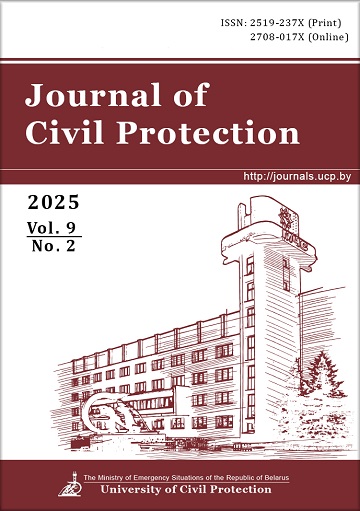Methodology of development of a training simulator for preparing specialists of state fire supervision bodies with the use of virtual reality technology
DOI:
https://doi.org/10.33408/2519-237X.2025.9-2.184Keywords:
computer modeling, virtual reality, simulator, supervision activities, fire safety, industrial safety, training locations, methodological supportAbstract
Purpose. To develop methodological foundations of software for creating a training simulator using computer modeling and virtual reality technologies based on the example of a shopping and entertainment center.
Methods. The analysis of fire danger at shopping and entertainment centers, the causes of fires and deaths at them. The generalosation of the requirements of regulatory legal acts including both technical regulatory legal and international acts in the field of fire safety ensuring, forming a system of fire safety regulation and standardization, as well as requirements in the field of industrial safety. The development of a three-dimensional virtual environment using the Unreal Engine software environment and objects for filling training locations. The synthesis of requirements in the field of fire and industrial safety, generated indicators for virtual training locations (facilities) to ensure and implement in the simulator the areas of supervision (control) by the (supervisory) authorities of the Ministry for Emergency Situations of the Republic of Belarus.
Findings. A methodology has been developed for the training simulator, including software algorithms, training locations, their description, operating modes and features of interaction with special objects, building planning schemes, justification of the use of structural element parameters, lists of possible violations of fire and industrial safety requirements for training locations (facilities). Based on the developed methodological support, a software product (training simulator) is being developed, which is represented by a virtual environment in the form of a three-dimensional model of a shopping and entertainment center with designed training locations in the Unreal Engine software environment.
Application field of research. The results obtained make it possible to ensure the introduction of computer modeling technologies, virtual reality and modern interactive teaching methods into the educational process to increase the effectiveness of the educational process in the training of specialists, who carry out state supervision in the field of fire and industrial safety.
References
Trushkin D.V., Korol'chenko A.Ya. Analiz prichin gibeli lyudey na pozhare v torgovom tsentre [Analysis of the causes of death in a fire in a shopping center]. Fire and explosion safety, 2007. Vol. 16, No. 2. Pp. 63–66. (rus). EDN: https://elibrary.ru/KNUVPF.
Feofanov A.N., Okhmat A.V., Berdyugin A.V. VR/AR tekhnologii i ikh primenenie v mashinostroenii [VR/AR technologies and their application in mechanical engineering]. Automation and Modeling in Design and Management, 2019. No. 4 (6). Pp. 44–48. (rus). DOI: https://doi.org/10.30987/2658-3488-2019-2019-4-44-48. EDN: https://elibrary.ru/GQBNQC.
Kulakov P.A., Eremin A.S. Osobennosti razrabotki komp'yuternykh obuchayushchikh trenazherov v UNITY 3D [Peculiarities of development of computer training simulators in UNITY 3D]. Izvestiya Tula State University. Technical sciences, 2024. Iss. 1. Pp. 177–181. (rus). DOI: https://doi.org/10.24412/2071-6168-2024-1-177-178. EDN: https://elibrary.ru/ZYZMAG.
Pozharkova I.N. Funktsional'naya model' virtual'nogo trenazhera dlya organizatsii trenirovok po evakuatsii [Functional model of a virtual simulator for organizing evacuation training]. Engineering Journal of Don, 2024. No. 6. 11 p. (rus). EDN: https://elibrary.ru/FHHMOM.
Andrushko D.Yu. Primenenie tekhnologiy virtual'noy i dopolnennoy real'nosti v obrazovatel'nom protsesse: problemy i perspektivy [Application of virtual and augmented reality technology in educational process: issues and perspectives]. Scientific Review. Pedagogical Sciences, 2018. No. 6. Pp. 5–10. (rus). EDN: https://elibrary.ru/YVRGBV.
Palevoda I.I., Ivanitskiy A.G., Mikanovich A.S., Pastukhov S.M., Grachulin A.V., Ryabtsev V.N., Navrotskiy O.D., Likhomanov A.O., Vinyarskiy G.V., Gusarov I.S. Tekhnologii virtual'noy i dopolnennoy real'nosti v obrazovatel'nom protsesse [Vrtual and augmented reality technologies in the educational process]. Journal of Civil Protection, 2022. Vol. 6, No. 1. Pp. 119–142. (rus). DOI: https://doi.org/10.33408/2519-237X.2022.6-1.119. EDN: https://elibrary.ru/FVSVOO.
Kornilov Yu.V., Popov A.A. VR-tekhnologii v obrazovanii: opyt, obzor instrumentov i perspektivy primeneniya [VR-technologies in education: experience, review of instruments and application prospects]. Innovations in Education, 2018, No. 8, Pp. 117–129. (rus). EDN: https://elibrary.ru/XUKYNN.
Palevoda I.I., Ryabtsev V.N., Likhomanov A.O., Navrotskiy O.D., Grachulin A.V., Gapanyuk D.V., Morozov A.A., Klimovtsov V.M., Vinyarskiy G.V., Shinkorenko K.E., Gusarov I.S., Bobarika I.V. Eksperimental'nyy maket trenazhera s imitatsiey effektov fizicheskikh vozdeystviy v usloviyakh virtual'noy real'nosti dlya podgotovki spasateley-pozharnykh [Experimental model of the simulator with imitation of the effects of physical impacts in virtual reality for the training of firefighters]. Journal of Civil Protection, 2022. Vol. 6, No. 3. Pp. 339–360. (rus). DOI: https://doi.org/10.33408/2519-237X.2022.6-3.339. EDN: https://elibrary.ru/QOKLBI.
Published
How to Cite
License
Copyright (c) 2025 Palevoda I.I., Korotkevich S.G., Nekhan' D.S., Kovtun V.A., Surikov A.V., Ryabtsev V.N.

This work is licensed under a Creative Commons Attribution-NonCommercial 4.0 International License.




















